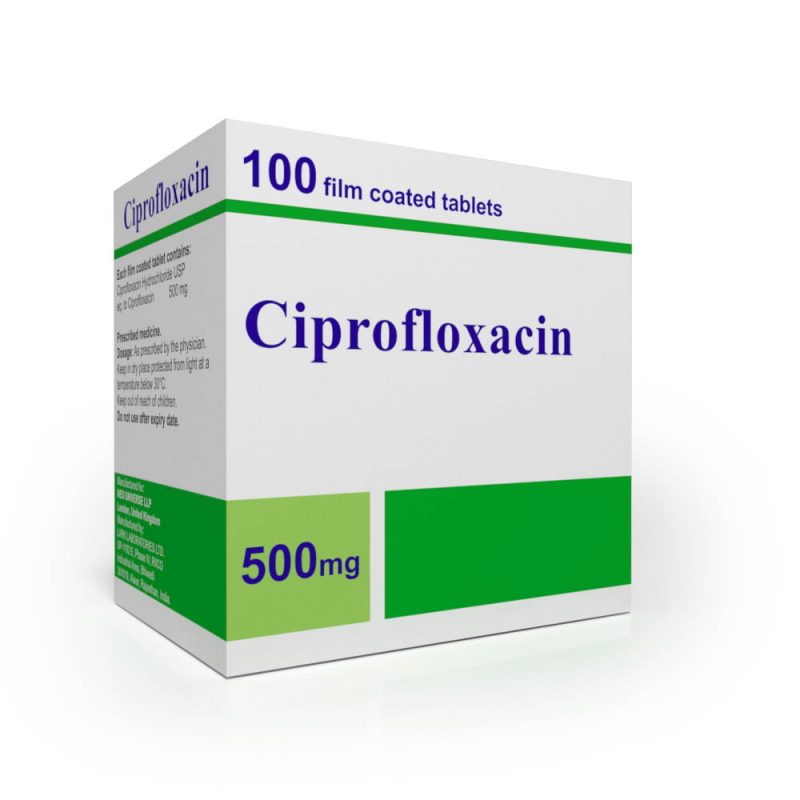
Ciprofloxacin Tablets
Prescription
Download the instruction
Ciprofloxacin has in vitro activity against a wide range of gram-negative and gram-positive microorganisms.
Composition
Each film coated tablet contains: ciprofloxacin Hydrochloride USP eq. to Ciprofloxacin – 500 mg.
Indications for use
The Ciprofloxacin is indicated for the treatment of the following infections. Special attention should be paid to available information on resistance to ciprofloxacin before commencing therapy.
Adults:
Lower respiratory tract infections due to Gram-negative bacteria:
- exacerbations of chronic obstructive pulmonary disease;
- broncho-pulmonary infections in cystic fibrosis or in bronchiectasis, pneumonia;
- chronic suppurative otitis media;
Acute exacerbation of chronic sinusitis especially if these are caused by Gram-negative bacteria:
- urinary and genital tract infections
- gonococcal uretritis and cervicitis due to susceptible Neisseria gonorrhoeae
- epididymo-orchitis including cases due to susceptible Neisseria gonorrhoeae
- pelvic inflammatory disease including cases due to susceptible Neisseria gonorrhoeae
- Infections of the gastro-intestinal tract (e.g. travellers’ diarrhoea)
- Intra-abdominal infections
- Infections of the skin and soft tissue caused by Gram-negative bacteria
- Malignant external otitis
- Infections of the bones and joints
- Prophylaxis of invasive infections due to Neisseria meningitidis
- Inhalation anthrax (post-exposure prophylaxis and curative treatment).
- Ciprofloxacin may be used in the management of neutropenic patients with fever that is suspected to be due to a bacterial infection.
Children and adolescents:
- Broncho-pulmonary infections in cystic fibrosis caused by Pseudomonas aeruginosa
- Complicated urinary tract infections and pyelonephritis
- Inhalation anthrax (post-exposure prophylaxis and curative treatment).
Ciprofloxacin may also be used to treat severe infections in children and adolescents when this is considered to be necessary.
Treatment should be initiated only by physicians who are experienced in the treatment of cystic fibrosis and/or severe infections in children and adolescents.
Ciprofloxacin is not a drug of first choice in the pediatric population due to an increased incidence of adverse events compared to controls, including events related to joints and/or surrounding tissues.
Mode of application
Tablets are to be swallowed unchewed with fluid. They can be taken independent of mealtimes. If taken on an empty stomach, the active substance is absorbed more rapidly.
The determination of dosage for any particular patient must take into consideration the severity and nature of the infection, the susceptibility of the causative organism, the integrity of the patient’s host-defense mechanisms, and the status of renal function and hepatic function.
Urinary Tract: acute uncomplicated – 250 mg every 12 hours during 3 days; severe/complicated – 500 mg every 12 hours during 7 to 14 days.
Chronic Bacterial Prostatitis: 500 mg every 12 hours during 28 days.
Lower Respiratory Tract: mild/moderate – 500 mg every 12 hours during 7 to 14 days; severe/complicated – 750 mg every 12 hours during 7 to 14 days.
Acute Sinusitis: 500 mg every 12 hours during 10 days.
Intra-Abdominal: 500 mg every 12 hours during 7 to 14 days.
Infectious Diarrhea: 500 mg every 12 hours during 5 to 7 days.
The duration of treatment depends upon the severity of infection. The usual duration is 7 to 14 days; however, for severe and complicated infections more prolonged therapy may be required.
Pediatrics dosage:
Cystic fibrosis: 20 mg/kg body weight twice daily with a maximum of 750 mg per dose. Total duration of treatment is 10 to 14 days.
Complicated urinary tract infections and pyelonephritis: 10 mg/kg body weight twice daily to 20 mg/kg body weight twice daily with a maximum of 750 mg per dose. Total duration of treatment is 10 to 21 days.
Inhalation anthrax post-exposure prophylaxis and curative treatment for persons able to receive treatment by oral route when clinically appropriate.
Drug administration should begin as soon as possible after suspected or confirmed exposure: 10 mg/kg body weight twice daily to 15 mg/kg body weight twice daily with a maximum of 500 mg per dose. Total duration of treatment is 60 days from the confirmation of Bacillus anthracis exposure.